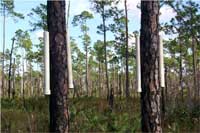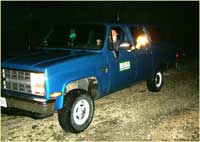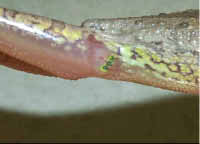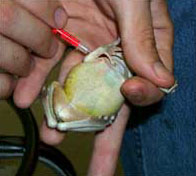Amphibian Inventory of Everglades National Park and Big Cypress National Preserve
Poster presented December 2000, at the Greater Everglades Ecosystem Restoration Conference
J. Hardin Waddle1,2, Kenneth G. Rice1, H. Franklin Percival2, Raymond R. Carthy2, and Melanie C. Caudill1,2
[Disclaimer]
 The southern toad, Bufo terrestris [larger image] |
 The Florida leopard frog, Rana sphenocephala [larger image] |
BACKGROUND
Scientists have recently documented world-wide declines in many amphibian species (Alford and Richards 1999). These declines may take several forms (species extinctions, deformities, etc.), and apparently come from several different causes (environmental contamination, loss or degradation of habitat, etc.). Because of the public and scientific concern for the alarming trends in amphibian populations, the U.S. Geological Survey, Biological Resources Division has been asked to begin work assessing the status and trends of amphibians on lands managed by the Department of the Interior. This national-level project has been named the Amphibian Research and Monitoring Initiative (ARMI). The Florida Caribbean Science Center is leading the ARMI project in the southeastern United States (SEARMI). This poster describes the work being done by SEARMI in Everglades National Park and Big Cypress National Preserve.
PROJECT OVERVIEW
Before a long-term monitoring project can be established to document the status and trends of amphibians in the Everglades, it is important that a thorough inventory be conducted.
- The primary goal of our study is to create an inventory of the amphibians in the Everglades. In addition to verifying the species list, we will examine the habitat associations and geographical distributions of the amphibians of the region.
- Sites within each major habitat type are visited during each season so that habitat and seasonal effects can be examined.
- A secondary objective of this project is to develop new methods appropriate for sampling amphibians in the Everglades.
- To maximize the number of species found, we are using a variety of methods like time constrained searches, visual encounter surveys, and call counts.
- We are also developing new methods of analyzing data that may be appropriate for future monitoring projects.
- We will be estimating detection probabilities for some of the species which will allow us to better estimate the number of individuals in a population (Nichols et al. 2000).
- We are developing a new method of estimating species richness using mark-recapture models that will be useful for comparing between sites (Nichols and Conroy 1996).
AMPHIBIANS AND EVERGLADES RESTORATION
- Amphibians are thought to be important indicators of ecosystem health.
Because of their permeable skin and aquatic life history they are especially susceptible to environmental contaminants. The effect of contaminants on amphibians in the Everglades is not well known.
- Changes in hydrology have the potential to cause shifts in amphibian populations.
Without a good understanding of the importance of different habitats to amphibians, it is impossible to know how proposed changes in hydrology will affect amphibian populations.
- The impact of introduced amphibian species may be increased by disturbance.
Cuban treefrogs appear to be more abundant near roads and buildings. Giant toads have only recently been discovered in Everglades National Park, but they will probably spread along roads and canals. Greenhouse frogs are ubiquitous wherever there are buildings and landscaping.

The Cuban treefrog,
Osteopilus septrionalis
[larger image]
The giant toad,
Bufo marinus
[larger image]
The greenhouse frog,
Eleutherodactylus planirostris
[larger image] - Perhaps the greatest threat to amphibians in Florida is loss of habitat.
As we learn more about the critical habitat needs of amphibian species, we will be able to help make management recommendations to decision makers involved in Everglades restoration.
LITERATURE CITED
Alford, R. A. and S. J. Richards. 1999. Global amphibian declines: a problem in applied ecology. Ann. Rev. Ecol. Syst. 30:133-165.
Nichols, J. D. and M. J. Conroy. 1996. Estimation of species richness. Pp. 226-234 in Measuring and Monitoring Biodiversity: Standard Methods for Mammals. Wilson, D. E., F. R. Cole, J. D. Nichols, R. Rudran, and M. S. Foster (eds.) Smithsonian Institution Press, Washington D.C.
Nichols, J. D., J. E. Hines, J. R. Sauer, F. W. Fallon, J. E. Fallon, and P. J. Heglund. 2000. A double-observer approach for estimating detection probability and abundance from point counts. The Auk 117(2):393-408.
ACKNOWLEDGEMENTS
This project is funded by the National Park Service through a grant to the U.S. Geological Survey, Biological Resources Division to conduct amphibian inventories at PrimeNet parks. The University of Florida Cooperative Fish and Wildlife Research Center, Restoration Ecology Branch of the USGS-BRD Florida Caribbean Science Center, and Everglades National Park have all provided equipment and support.
We would like to thank Adam Finger for hard work in the field and Tori Foster for assistance in making this poster.
 Click here for a printable version of this poster (note: document will open in a new browser window)
Click here for a printable version of this poster (note: document will open in a new browser window)









